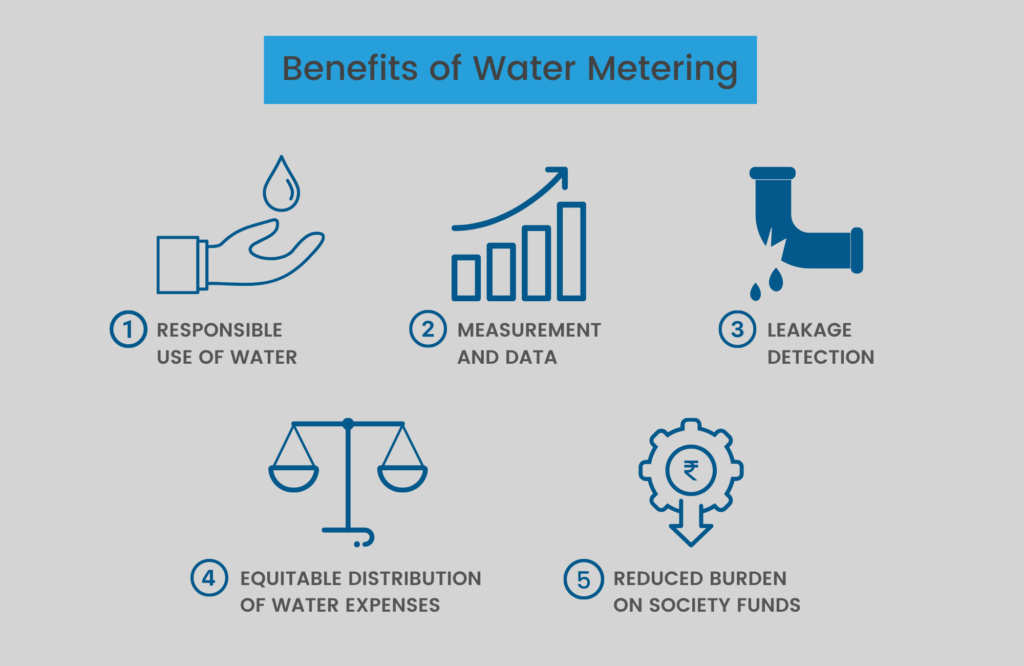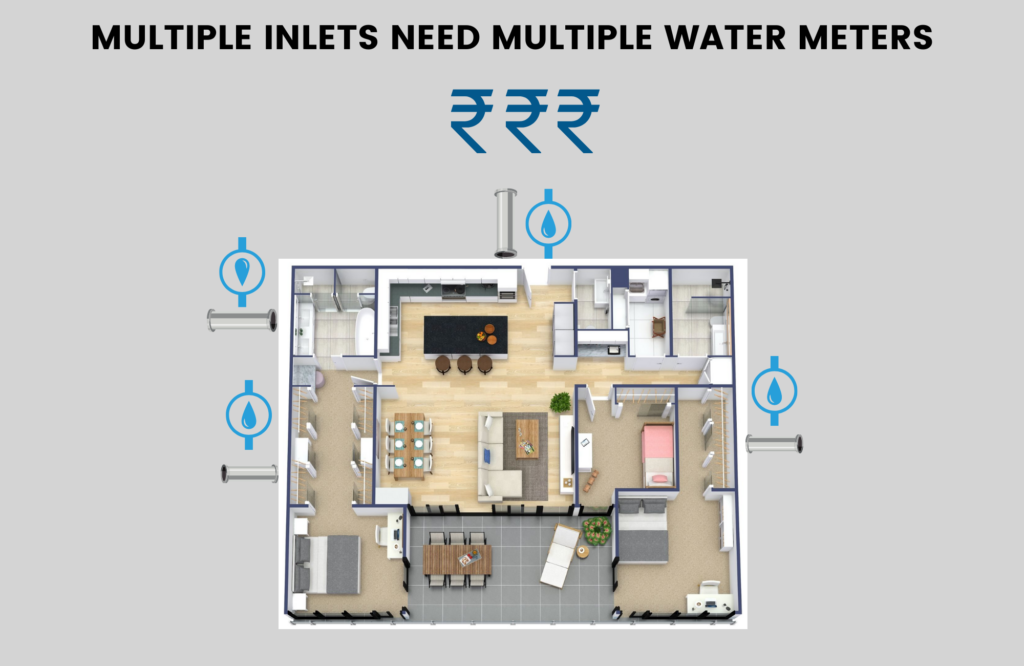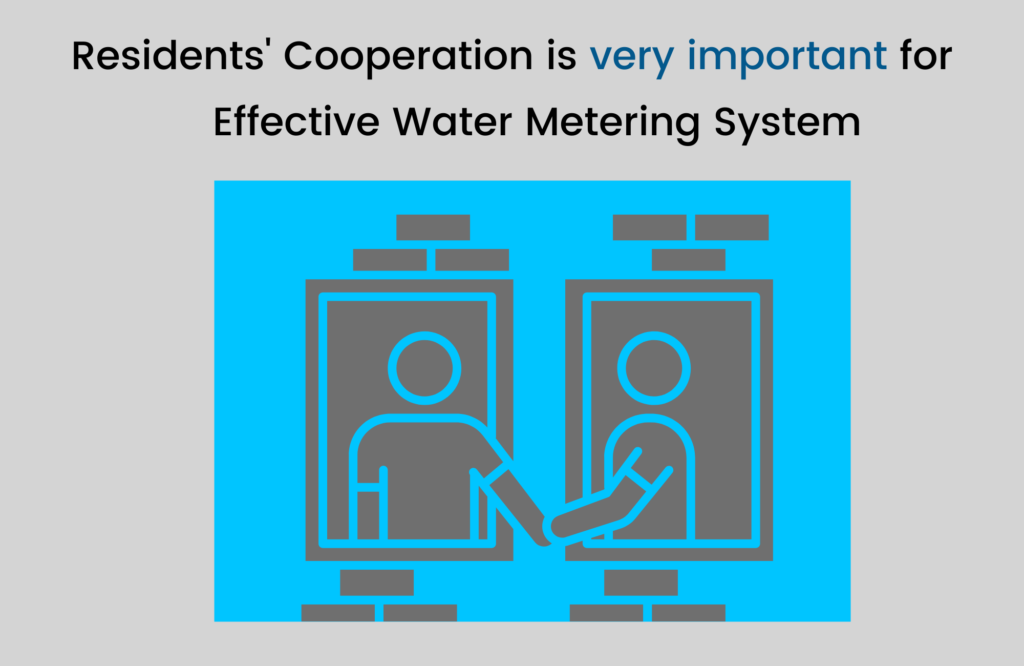Individual Water Metering – Is it practical?
With growing water costs, housing societies are looking at ways in which they can get residents to cut down on water wastage and use water responsibly. One of the ways to do this would be to install individual water meters so that residents can be billed for their water consumption. While, on paper, this sounds like a simple and obvious solution, it can get very tricky to execute in reality. Let’s examine it in depth.
Table of Contents
What Is Individual Water Metering?
Typically, housing societies in India pay their water bills out of the society maintenance funds on a collective basis. Water costs are divided equally among all residents and there is no provision to charge households based on their individual water consumption.
Individual water metering enables the society to monitor the volume of water utilised by each flat and thus bill them accordingly.
It involves installing water meters in each inlet pipe coming into the flat, checking their readings monthly and billing them as per the readings through a Water Management App or some other kind of system. Various water technologies for metering and billing are available in the market today.
We have summarized them here
Prepaid Water Meters
Residents can choose to install prepaid water meters where a fixed volume of water is available to each flat without any charge. After that threshold is reached, the resident would have to charge the water meter to receive more water.
Pay as You Go
Residents receive a monthly water bill based on the volume of water consumed each month.
Manual Reading
These are old type water meters which show readings in a digital format. They do not have the capability to transmit their readings wirelessly. Typically, the security guard or some other maintenance person takes periodic rounds to note down the meter reading in a register. The customer is then sent a bill as per that reading.
Advanced Water Technologies – Wireless, Leak Detection
These days, we have IoT enabled water meters which have the capability to transmit readings wirelessly. A complete billing system is integrated into the product so that the customer receives and pays their bill digitally on a regular basis.
These systems have advanced analytics and algorithms built into them so that they can detect leakages and raise an alert if needed. They also provide central dashboards and water management apps so that users can study and analyze their water consumption.
Supply Control and Cut Off
In addition to water meters, these systems also come with solenoid valves. These valves have the capability to shut off the water supply from the pipe in case of leakages, or if the bill has not been paid.
In IoT enabled systems the valves can be controlled remotely via a phone or PC.
Now that we have seen the various types of water metering solutions available today, let us look at the benefits of having such a system in your community.
Benefits of Individual Water Metering

Responsible Use of Water
- The first and the most obvious benefit is that everyone becomes conscious of their water consumption.
- When people are directly billed for their water usage, they automatically start implementing ways of reducing their consumption.
Measurement and Data
- Water related data and numbers are available to residents which can be analyzed and optimized
- For e.g., if the society sees a major chunk of its water consumption comes from watering the community gardens rather than from individual flats, it can focus its efforts on reducing the water needed for gardening by adopting techniques such as mulching.
- Data analysis can provide multiple ideas for water conservation, unique to each society
- Here we have described some of the drawbacks of the current residential Water Management System and how it can be improved with instrumentation.
Leakage Detection
- By tallying the water usage of its residents with the total water received for that period, society can detect if there are any leakages, losses or inefficiencies in their structure.
Equitable distribution of Water Expenses
- If a society is paying heavily for their water usage, it is natural to have a feeling of discontent amongst its members especially if they see others wasting water or if many members are sharing one apartment.
- Holding every house responsible for their water bill helps to create a feeling of fairness among the members. Members are more likely to cooperate when paying maintenance charges.
Reduced Burden on Society Funds
- Sometimes, when the builder or corporation does not provide water to the society and the society needs to spend out of its pocket for water, a major chunk of the maintenance charges get used up in water expenses.
- These charges increase during summers when there is water scarcity.
- It is difficult to plan for them and water metering and individual billing helps to take that load off the society.
While there are many benefits and very few cons to having an individual water metering system, it has not become popular in India yet as there are many challenges involved in the installation and implementation of such a system. Let’s take a deeper look.
Challenges of Individual Water Metering
Instrumentation Complexities
1) Multiple Inlets into the Apartment
Typically housing societies are constructed such that there are multiple water pipes coming into a single flat. For e.g. Each bathroom is supplied by a separate pipe, the kitchen has a separate inlet and sometimes the flushing water comes in from a separate inlet.
In such a case water metering for individual flats becomes a highly expensive proposition as water meters need to be installed in each inlet coming into the apartment.

2) Tricky Installation
Water meter installations are quite complex as they require the level to be perfectly horizontal and involve cutting of pipes. Sometimes some debris such as stones, pebbles, leaves, twigs can flow with the water and get stuck in the meter and obstruct it’s work. The only way to identify this is to open up the complete connection.
In addition, some types of water meters require water of certain pressure to be flowing in the pipes for it to measure it accurately. It can be challenging to find a spot with that kind of pressure for each inlet.
As water meters derive water volumes indirectly, equipment calibration is a very important aspect of installation. The meters need to be calibrated accurately else the readings will be inaccurate.
3) Solution is expensive
When installing water meters, it makes sense to install solenoid valves as well. Valves make the meters actionable, that is, the supply can be cut off if there’s a leakage or if the member is not paying their water dues.However, typically, the society or the builder spends a significant amount on providing efficient water management by installing equipment such as water level indicators and Water Level Controller. Valves and water meters add to the cost of water management and the complete solution can become quite expensive.

Residents’ Cooperation
Housing societies are governed by the laws of cooperative bodies. Not much authority is vested in the hands of the managing committee members. If residents choose not to cooperate, not much can be done.
Housing societies are loose bodies consisting of people from different cultures, backgrounds, attitudes and age groups. Sometimes residents may choose to disagree with the water meter readings, distrust the billing company or tamper with the water meters.
If the flats are unoccupied most of the time, the owners refuse to pay minimal charges or residents refuse to pay for the time that they were away on a vacation. If the system goes down for a certain period, there can be conflicts around how to account for water usage during down time.
This puts additional responsibility on the shoulders of the managing committee which is already working on a voluntary basis. In addition, bylaws of housing societies are structured in such a way that they disallow cooperative housing societies to charge individual apartments for water. May be the society has to come up with creative solutions to reduce water consumption before navigating this terrain.

As described above, while an individual water meter sounds like the perfect solution to make each household accountable for its water consumption, it can be quite a challenge to actually implement it in practice. Each society is unique in terms of its construction, people and water situation. Thus it’s up to the society to validate the pros and cons of such a solution within the context of its conditions, and decide the best way forward.
